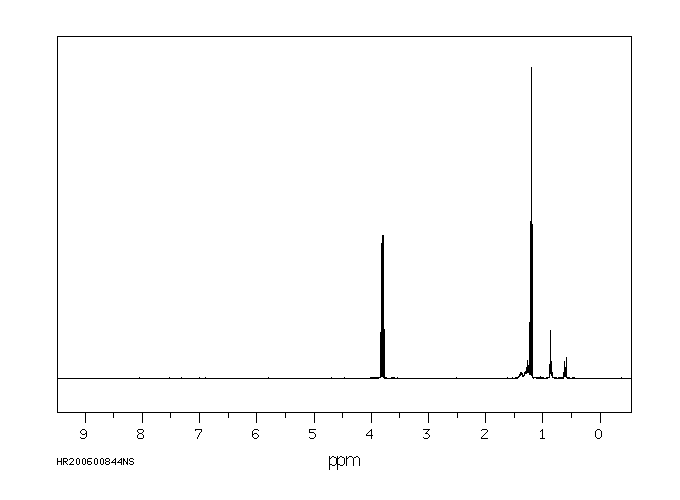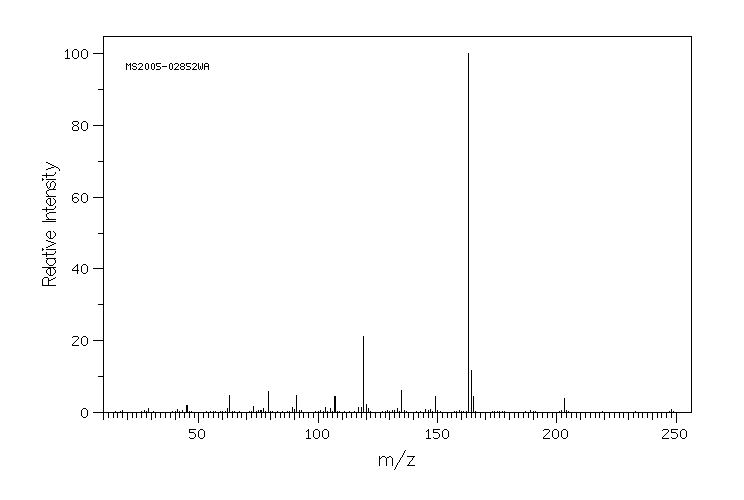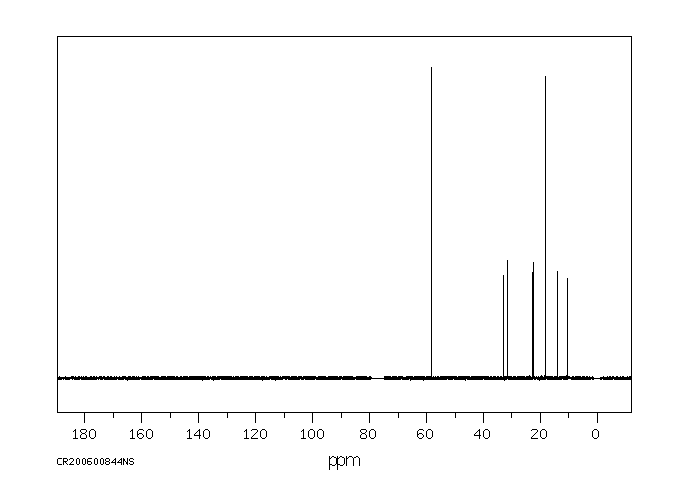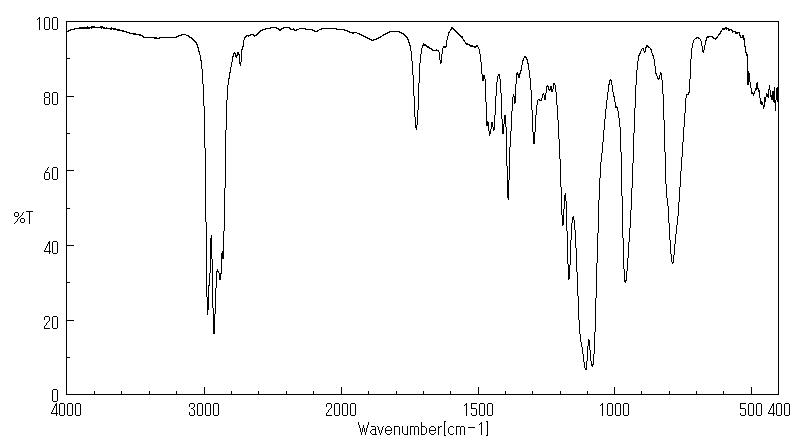正己基三乙氧基硅烷 | 18166-37-5
中文名称
正己基三乙氧基硅烷
中文别名
己基三乙氧基硅烷;三乙氧基己基硅烷
英文名称
hexyltriethoxysilane
英文别名
1-triethoxysilylhexane;hexyl(triethoxy)silane;n-hexyltriethoxysilane;triethoxy(hexyl)silane;triethoxy-hexyl-silane;Triaethoxy-hexyl-silan
CAS
18166-37-5
化学式
C12H28O3Si
mdl
MFCD00087744
分子量
248.438
InChiKey
WUMSTCDLAYQDNO-UHFFFAOYSA-N
BEILSTEIN
——
EINECS
——
-
物化性质
-
计算性质
-
ADMET
-
安全信息
-
SDS
-
制备方法与用途
-
上下游信息
-
文献信息
-
表征谱图
-
同类化合物
-
相关功能分类
-
相关结构分类
计算性质
-
辛醇/水分配系数(LogP):3.63
-
重原子数:16
-
可旋转键数:11
-
环数:0.0
-
sp3杂化的碳原子比例:1.0
-
拓扑面积:27.7
-
氢给体数:0
-
氢受体数:3
安全信息
-
TSCA:No
-
安全说明:S26,S36/37/39
-
危险类别码:R36/38
-
海关编码:2931900090
-
危险性防范说明:P210,P264,P280,P302+P352+P332+P313+P362+P364,P305+P351+P338+P337+P313,P370+P378,P403+P235,P501
-
危险性描述:H227,H315,H319
-
储存条件:常温密闭避光,储存在通风、干燥的惰性气体环境中。
SDS
己基三乙氧基硅烷 修改号码:5
模块 1. 化学品
产品名称: Hexyltriethoxysilane
修改号码: 5
模块 2. 危险性概述
GHS分类
物理性危害
易燃液体 第4级
健康危害
皮肤腐蚀/刺激 第2级
严重损伤/刺激眼睛 2A类
环境危害 未分类
GHS标签元素
图标或危害标志
信号词 警告
危险描述 可燃液体
造成皮肤刺激
造成严重眼刺激
防范说明
[预防] 远离明火/热表面。
处理后要彻底清洗双手。
穿戴防护手套/护目镜/防护面具。
[急救措施] 眼睛接触:用水小心清洗几分钟。如果方便,易操作,摘除隐形眼镜。继续冲洗。
眼睛接触:求医/就诊
皮肤接触:用大量肥皂和水轻轻洗。
若皮肤刺激:求医/就诊。
脱掉被污染的衣物,清洗后方可重新使用。
[储存] 存放于通风良好处。保持凉爽。
[废弃处置] 根据当地政府规定把物品/容器交与工业废弃处理机构。
己基三乙氧基硅烷 修改号码:5
模块 3. 成分/组成信息
单一物质/混和物 单一物质
化学名(中文名): 己基三乙氧基硅烷
百分比: >97.0%(GC)
CAS编码: 18166-37-5
俗名: Triethoxyhexylsilane
分子式: C12H28O3Si
模块 4. 急救措施
吸入: 将受害者移到新鲜空气处,保持呼吸通畅,休息。若感不适请求医/就诊。
皮肤接触: 立即去除/脱掉所有被污染的衣物。用大量肥皂和水轻轻洗。
若皮肤刺激或发生皮疹:求医/就诊。
眼睛接触: 用水小心清洗几分钟。如果方便,易操作,摘除隐形眼镜。继续清洗。
如果眼睛刺激:求医/就诊。
食入: 若感不适,求医/就诊。漱口。
紧急救助者的防护: 救援者需要穿戴个人防护用品,比如橡胶手套和气密性护目镜。
模块 5. 消防措施
合适的灭火剂: 干粉,泡沫,二氧化碳
不适用的灭火剂: 水(有可能扩大灾情。)
特殊危险性: 小心,燃烧或高温下可能分解产生毒烟。
特定方法: 从上风处灭火,根据周围环境选择合适的灭火方法。
非相关人员应该撤离至安全地方。
周围一旦着火:如果安全,移去可移动容器。
消防员的特殊防护用具: 灭火时,一定要穿戴个人防护用品。
模块 6. 泄漏应急处理
个人防护措施,防护用具, 使用个人防护用品。远离溢出物/泄露处并处在上风处。确保足够通风。
紧急措施: 泄露区应该用安全带等圈起来,控制非相关人员进入。
环保措施: 防止进入下水道。
控制和清洗的方法和材料: 用合适的吸收剂(如:旧布,干砂,土,锯屑)吸收泄漏物。一旦大量泄漏,筑堤控
制。附着物或收集物应该立即根据合适的法律法规废弃处置。
副危险性的防护措施 移除所有火源。一旦发生火灾应该准备灭火器。使用防火花工具和防爆设备。
模块 7. 操作处置与储存
处理
技术措施: 在通风良好处进行处理。穿戴合适的防护用具。防止烟雾产生。远离明火和热表面。
采取措施防止静电积累。使用防爆设备。处理后彻底清洗双手和脸。
注意事项: 使用封闭系统,通风。
操作处置注意事项: 避免接触皮肤、眼睛和衣物。
贮存
储存条件: 保持容器密闭。存放于凉爽、阴暗、通风良好处。
存放于惰性气体环境中。
防湿。
远离不相容的材料比如氧化剂存放。
潮敏
包装材料: 依据法律。
己基三乙氧基硅烷 修改号码:5
模块 8. 接触控制和个体防护
工程控制: 尽可能安装封闭体系或局部排风系统,操作人员切勿直接接触。同时安装淋浴器和洗
眼器。
个人防护用品
呼吸系统防护: 防毒面具。依据当地和政府法规。
手部防护: 防护手套。
眼睛防护: 安全防护镜。如果情况需要,佩戴面具。
皮肤和身体防护: 防护服。如果情况需要,穿戴防护靴。
模块 9. 理化特性
外形(20°C): 液体
外观: 透明
颜色: 无色-几乎无色
气味: 无资料
pH: 无数据资料
熔点: 无资料
沸点/沸程 115 °C/2.4kPa
闪点: 95°C
爆炸特性
爆炸下限: 无资料
爆炸上限: 无资料
密度: 0.88
溶解度:
[水] 无资料
[其他溶剂] 无资料
模块 10. 稳定性和反应性
化学稳定性: 一般情况下稳定。
危险反应的可能性: 未报道特殊反应性。
避免接触的条件: 明火
须避免接触的物质 氧化剂
危险的分解产物: 一氧化碳, 二氧化碳, 氧化硅
模块 11. 毒理学信息
急性毒性: 无资料
对皮肤腐蚀或刺激: 无资料
对眼睛严重损害或刺激: 无资料
生殖细胞变异原性: 无资料
致癌性:
IARC = 无资料
NTP = 无资料
生殖毒性: 无资料
模块 12. 生态学信息
生态毒性:
鱼类: 无资料
甲壳类: 无资料
藻类: 无资料
残留性 / 降解性: 无资料
潜在生物累积 (BCF): 无资料
己基三乙氧基硅烷 修改号码:5
模块 12. 生态学信息
土壤中移动性
log水分配系数: 无资料
土壤吸收系数 (Koc): 无资料
亨利定律 无资料
constaNT(PaM3/mol):
模块 13. 废弃处置
如果可能,回收处理。请咨询当地管理部门。建议在装有后燃和洗涤装置的化学焚烧炉中焚烧。废弃处置时请遵守
国家、地区和当地的所有法规。
模块 14. 运输信息
联合国分类: 与联合国分类标准不一致
UN编号: 未列明
模块 15. 法规信息
《危险化学品安全管理条例》(2002年1月26日国务院发布,2011年2月16日修订): 针对危险化学品的安全使用、
生产、储存、运输、装卸等方面均作了相应的规定。
模块16 - 其他信息
N/A
模块 1. 化学品
产品名称: Hexyltriethoxysilane
修改号码: 5
模块 2. 危险性概述
GHS分类
物理性危害
易燃液体 第4级
健康危害
皮肤腐蚀/刺激 第2级
严重损伤/刺激眼睛 2A类
环境危害 未分类
GHS标签元素
图标或危害标志
信号词 警告
危险描述 可燃液体
造成皮肤刺激
造成严重眼刺激
防范说明
[预防] 远离明火/热表面。
处理后要彻底清洗双手。
穿戴防护手套/护目镜/防护面具。
[急救措施] 眼睛接触:用水小心清洗几分钟。如果方便,易操作,摘除隐形眼镜。继续冲洗。
眼睛接触:求医/就诊
皮肤接触:用大量肥皂和水轻轻洗。
若皮肤刺激:求医/就诊。
脱掉被污染的衣物,清洗后方可重新使用。
[储存] 存放于通风良好处。保持凉爽。
[废弃处置] 根据当地政府规定把物品/容器交与工业废弃处理机构。
己基三乙氧基硅烷 修改号码:5
模块 3. 成分/组成信息
单一物质/混和物 单一物质
化学名(中文名): 己基三乙氧基硅烷
百分比: >97.0%(GC)
CAS编码: 18166-37-5
俗名: Triethoxyhexylsilane
分子式: C12H28O3Si
模块 4. 急救措施
吸入: 将受害者移到新鲜空气处,保持呼吸通畅,休息。若感不适请求医/就诊。
皮肤接触: 立即去除/脱掉所有被污染的衣物。用大量肥皂和水轻轻洗。
若皮肤刺激或发生皮疹:求医/就诊。
眼睛接触: 用水小心清洗几分钟。如果方便,易操作,摘除隐形眼镜。继续清洗。
如果眼睛刺激:求医/就诊。
食入: 若感不适,求医/就诊。漱口。
紧急救助者的防护: 救援者需要穿戴个人防护用品,比如橡胶手套和气密性护目镜。
模块 5. 消防措施
合适的灭火剂: 干粉,泡沫,二氧化碳
不适用的灭火剂: 水(有可能扩大灾情。)
特殊危险性: 小心,燃烧或高温下可能分解产生毒烟。
特定方法: 从上风处灭火,根据周围环境选择合适的灭火方法。
非相关人员应该撤离至安全地方。
周围一旦着火:如果安全,移去可移动容器。
消防员的特殊防护用具: 灭火时,一定要穿戴个人防护用品。
模块 6. 泄漏应急处理
个人防护措施,防护用具, 使用个人防护用品。远离溢出物/泄露处并处在上风处。确保足够通风。
紧急措施: 泄露区应该用安全带等圈起来,控制非相关人员进入。
环保措施: 防止进入下水道。
控制和清洗的方法和材料: 用合适的吸收剂(如:旧布,干砂,土,锯屑)吸收泄漏物。一旦大量泄漏,筑堤控
制。附着物或收集物应该立即根据合适的法律法规废弃处置。
副危险性的防护措施 移除所有火源。一旦发生火灾应该准备灭火器。使用防火花工具和防爆设备。
模块 7. 操作处置与储存
处理
技术措施: 在通风良好处进行处理。穿戴合适的防护用具。防止烟雾产生。远离明火和热表面。
采取措施防止静电积累。使用防爆设备。处理后彻底清洗双手和脸。
注意事项: 使用封闭系统,通风。
操作处置注意事项: 避免接触皮肤、眼睛和衣物。
贮存
储存条件: 保持容器密闭。存放于凉爽、阴暗、通风良好处。
存放于惰性气体环境中。
防湿。
远离不相容的材料比如氧化剂存放。
潮敏
包装材料: 依据法律。
己基三乙氧基硅烷 修改号码:5
模块 8. 接触控制和个体防护
工程控制: 尽可能安装封闭体系或局部排风系统,操作人员切勿直接接触。同时安装淋浴器和洗
眼器。
个人防护用品
呼吸系统防护: 防毒面具。依据当地和政府法规。
手部防护: 防护手套。
眼睛防护: 安全防护镜。如果情况需要,佩戴面具。
皮肤和身体防护: 防护服。如果情况需要,穿戴防护靴。
模块 9. 理化特性
外形(20°C): 液体
外观: 透明
颜色: 无色-几乎无色
气味: 无资料
pH: 无数据资料
熔点: 无资料
沸点/沸程 115 °C/2.4kPa
闪点: 95°C
爆炸特性
爆炸下限: 无资料
爆炸上限: 无资料
密度: 0.88
溶解度:
[水] 无资料
[其他溶剂] 无资料
模块 10. 稳定性和反应性
化学稳定性: 一般情况下稳定。
危险反应的可能性: 未报道特殊反应性。
避免接触的条件: 明火
须避免接触的物质 氧化剂
危险的分解产物: 一氧化碳, 二氧化碳, 氧化硅
模块 11. 毒理学信息
急性毒性: 无资料
对皮肤腐蚀或刺激: 无资料
对眼睛严重损害或刺激: 无资料
生殖细胞变异原性: 无资料
致癌性:
IARC = 无资料
NTP = 无资料
生殖毒性: 无资料
模块 12. 生态学信息
生态毒性:
鱼类: 无资料
甲壳类: 无资料
藻类: 无资料
残留性 / 降解性: 无资料
潜在生物累积 (BCF): 无资料
己基三乙氧基硅烷 修改号码:5
模块 12. 生态学信息
土壤中移动性
log水分配系数: 无资料
土壤吸收系数 (Koc): 无资料
亨利定律 无资料
constaNT(PaM3/mol):
模块 13. 废弃处置
如果可能,回收处理。请咨询当地管理部门。建议在装有后燃和洗涤装置的化学焚烧炉中焚烧。废弃处置时请遵守
国家、地区和当地的所有法规。
模块 14. 运输信息
联合国分类: 与联合国分类标准不一致
UN编号: 未列明
模块 15. 法规信息
《危险化学品安全管理条例》(2002年1月26日国务院发布,2011年2月16日修订): 针对危险化学品的安全使用、
生产、储存、运输、装卸等方面均作了相应的规定。
模块16 - 其他信息
N/A
反应信息
-
作为反应物:参考文献:名称:Andrianov,K.A.; Izmailov,B.A., Journal of general chemistry of the USSR, 1976, vol. 46, p. 115 - 117摘要:DOI:
-
作为产物:描述:硅酸四乙酯 在 Mg 作用下, 以 not given 为溶剂, 以45-50的产率得到正己基三乙氧基硅烷参考文献:名称:Adrianov, K.; Gribanova, O., Zhurnal Obshchei Khimii, 1938, vol. 8, p. 558 - 562摘要:DOI:
-
作为试剂:参考文献:名称:Organic phosphosilicon compounds of stereocyclic structure摘要:DOI:10.1007/bf00906499
文献信息
-
Ruthenium complexes with diazadienes作者:Heindirk tom Dieck、Ingo Kleinwächter、Erhard T.K. HauptDOI:10.1016/0022-328x(87)85043-x日期:1987.3Displacement of piperidine from Ru(COD)(piperidine)-trans-(H)Cl (I) by 1,4-diaza-1,3-dienes (DAD: RNCR′CR′NR) gives the complexes cis-Ru(COD)(DAD)-(H)Cl (III). With relatively bulky DAD ligands the complexes III are unstable and are converted into compounds IV, which are also formed from III on heating. Complexes III are not accessible from Ru(COD)(DAD)Cl2(V). If the analogous starting material involving1,4-二氮杂-1,3-二烯(DAD:RNCR'CR'NR)从Ru(COD)(哌啶)-反式(H)Cl(I)取代哌啶得到配合物顺式- Ru(COD)(DAD)-(H)Cl(III)。在具有相对大体积的DAD配体的情况下,配合物III不稳定并转化为化合物IV,其在加热时也由III形成。从Ru(COD)(DAD)Cl 2(V)无法获得络合物III 。如果使用涉及环庚三烯Ib代替COD配体的类似起始原料,则保留哌啶阴离子作为配体而不是氢化物。在室温下1刚性不对称III的1 H NMR光谱可以分别看到COD配体的所有12个氢原子。已通过使用2D-H / H相关光谱进行了完整分配。最高的场共振(1.2 ppm)归属于被DAD螯合物屏蔽的烯烃H原子。配合物III催化末端烯烃异构化为顺式/反式混合物()的内部烯烃。在1-烯烃的催化氢化硅烷化过程中,这种异构化是竞争性副反应。III的热分解得到游离的1,3-COD;
-
Application of polyethyleneglycol (PEG) functionalized ionic liquids for the rhodium-catalyzed hydrosilylation reaction of alkenes作者:Ying Bai、Fengxiang Zhang、Jiayun Li、Yisong Xu、Jiajian Peng、Wenjun XiaoDOI:10.1016/j.jorganchem.2015.06.024日期:2015.10used as a catalytic system for the hydrosilylation reaction of alkenes. The influence of the anion of the ionic liquid has been investigated. It was found that the anion has an impact on the catalytic activity and selectivity. [PEG400DIL][PF6]-[Rh(PPh3)3Cl] shows an improved catalytic performance towards the hydrosilylation reaction of alkenes. The scope of alkenes and recycling of the catalytic system
-
Hydrosilylation of olefins catalysed by trans-di-µ-hydrido-bis(tricyclohexylphosphine)bis(silyl)diplatinum complexes作者:Michael Green、John L. Spencer、F. Gordon A. Stone、Constantinos A. TsipisDOI:10.1039/dt9770001519日期:——The diplatinum complexes [Pt(SiR3)(µ-H)[(C6H11)3P]}2] catalyse the addition of silanes R3SiH (R = Me, Et, PhCH2, Ph, OEt, or Cl) to pent-1-ene, hex-1-ene, styrene, allyl chloride, and 2-methylpropene. Reactivity of the silanes is qualitatively in the order: Me2EtSiH ≃ Me2PhSiH ≃ Me2(PhCH2) SiH ClMe2SiH > Me3SiH > Cl3SiH Et3SiH (EtO)3SiH, except for allyl chloride for which it is Cl3SiH > Cl2MeSiH双铂配合物[Pt(SiR 3)(µ-H)[(C 6 H 11)3 P]} 2 ]催化硅烷R 3 SiH的添加(R = Me,Et,PhCH 2,Ph,OEt,或Cl)为戊-1-烯,己-1-烯,苯乙烯,烯丙基氯和2-甲基丙烯。硅烷的反应性从高到低依次为:Me 2 EtSiH≃Me 2 PhSiH≃Me 2(PhCH 2)SiH ClMe 2 SiH> Me 3 SiH> Cl 3 SiH Et 3 SiH (EtO)3 SiH,但烯丙基氯除外它是Cl3 SiH> Cl 2 MeSiH> Me 2 PhSiHClMe 2 SiH。加氢甲硅烷基化反应经常强烈放热,在催化剂:反应物比率为10 –4 –10 –6:1的情况下以高收率进行反应。六元-1,5-二烯,八元-1,7-二烯和4-乙烯基环己烯也会发生反应使用相同的催化剂体系,可以轻松地与硅烷一起使用。六(1,5-二烯)和八(1,7-二烯)可提
-
一种以可循环使用的铂化合物为催化剂的硅 氢加成反应
-
一种硅氢加成反应的方法
表征谱图
-
氢谱1HNMR
-
质谱MS
-
碳谱13CNMR
-
红外IR
-
拉曼Raman
-
峰位数据
-
峰位匹配
-
表征信息
同类化合物
(2-溴乙氧基)-特丁基二甲基硅烷
鲸蜡基聚二甲基硅氧烷
骨化醇杂质DCP
马沙骨化醇中间体
马来酸双(三甲硅烷)酯
顺式-二氯二(二甲基硒醚)铂(II)
顺-N-(1-(2-乙氧基乙基)-3-甲基-4-哌啶基)-N-苯基苯酰胺
降钙素杂质13
降冰片烯基乙基三甲氧基硅烷
降冰片烯基乙基-POSS
间-氨基苯基三甲氧基硅烷
镓,二(1,1-二甲基乙基)甲基-
镁,氯[[二甲基(1-甲基乙氧基)甲硅烷基]甲基]-
锑,二溴三丁基-
铷,[三(三甲基甲硅烷基)甲基]-
铂(0)-1,3-二乙烯-1,1,3,3-四甲基二硅氧烷
钾(4-{[二甲基(2-甲基-2-丙基)硅烷基]氧基}-1-丁炔-1-基)(三氟)硼酸酯(1-)
金刚烷基乙基三氯硅烷
酰氧基丙基双封头
达格列净杂质
辛醛,8-[[(1,1-二甲基乙基)二甲基甲硅烷基]氧代]-
辛甲基-1,4-二氧杂-2,3,5,6-四硅杂环己烷
辛基铵甲烷砷酸盐
辛基衍生化硅胶(C8)ZORBAX?LP100/40C8
辛基硅三醇
辛基甲基二乙氧基硅烷
辛基三甲氧基硅烷
辛基三氯硅烷
辛基(三苯基)硅烷
辛乙基三硅氧烷
路易氏剂-3
路易氏剂-2
路易士剂
试剂Cyanomethyl[3-(trimethoxysilyl)propyl]trithiocarbonate
试剂3-[Tris(trimethylsiloxy)silyl]propylvinylcarbamate
试剂3-(Trimethoxysilyl)propylvinylcarbamate
试剂2-(Trimethylsilyl)cyclopent-2-en-1-one
试剂11-Azidoundecyltriethoxysilane
西甲硅油杂质14
衣康酸二(三甲基硅基)酯
苯胺,4-[2-(三乙氧基甲硅烷基)乙基]-
苯磺酸,羟基-,盐,单钠聚合甲醛,1,3,5-三嗪-2,4,6-三胺和脲
苯甲醇,a-[(三苯代甲硅烷基)甲基]-
苯并磷杂硅杂英,5,10-二氢-10,10-二甲基-5-苯基-
苯基二甲基氯硅烷
苯基二甲基乙氧基硅
苯基二甲基(2'-甲氧基乙氧基)硅烷
苯基乙酰氧基三甲基硅烷
苯基三辛基硅烷
苯基三甲氧基硅烷










